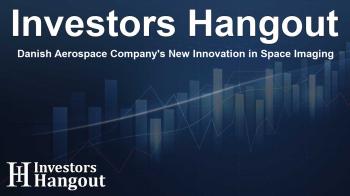Danish Aerospace Company's New Innovation in Space Imaging

Danish Aerospace Company Innovates Space Imaging Technology
In a significant advancement for astronaut health and well-being, the Danish Aerospace Company A/S (DAC) has embarked on an exciting collaboration with Adaptix Ltd. The focus of this partnership is the development of a pioneering 3D Bone Quality Imaging System intended for future use in space, particularly on missions lasting several months.
Collaboration with Adaptix Ltd.
Under a newly signed subcontract, DAC will work closely with Adaptix to create a prototype that leverages Adaptix’s advanced imaging technology. This collaboration is nested within a broader program initiated by the European Space Agency, with the ultimate goal of evolving this prototype into a sophisticated flight system capable of functioning in outer space, including potential applications on the International Space Station (ISS).
Key Features of the 3D Bone Quality Imaging System
The envisioned system will utilize cutting-edge Dual-Energy X-ray Absorptiometry (DEXA) technology for measuring bone density through digital tomosynthesis. This is crucial as astronauts on long-duration missions, commonly lasting four to six months, face significant risks of bone density loss. Studies indicate that these astronauts might experience over 10% reduction in bone mineral density, especially at vital sites like the hip and spine, which can lead to serious health consequences like fractures and kidney stones.
Importance in Space and Earth Applications
Interestingly, the technology being developed has implications that extend beyond space exploration. Both the mechanisms causing bone and muscle deterioration in microgravity and those observed in elderly populations or long-term hospitalized patients on Earth share similarities. This means that the innovations stemming from this project could ultimately contribute to healthcare solutions here on Earth.
Agreement Details and Expectations
The contract covers a duration of 24 months, with DAC's total commitment valued at around EUR 100,000 (approximately DKK 0.75 million). As part of the project, DAC and Adaptix will enhance the capabilities of the Adaptix’ Ortho350 system, adapting it for eventual integration into space missions, including on the ISS and for future commercial space ventures.
Despite the new developments, DAC remains steadfast in its previously communicated projections and commitments for the coming years.
DAC’s Legacy and Future Aspirations
This groundbreaking endeavor marks DAC's inaugural venture into the domain of bone imaging for space applications, a testament to the company’s resilience and innovation. As CEO Thomas A. E. Andersen expresses, the collaboration with Adaptix allows DAC to step into a challenging yet promising field. His confidence is bolstered by DAC's impressive track record of over 30 years, during which they have successfully launched more than 3.2 tons of their developed hardware into space.
DAC’s commitment to enhancing technology for space health applications is reflected in its history of developing and adapting various medical technologies. From respiratory equipment for spaceflight to specialized ergometers for astronauts, DAC continually seeks to bridge space technology with terrestrial benefits.
Contact and Company Information
For any inquiries regarding this innovative project or further information about DAC, interested parties can reach out to:
Danish Aerospace Company A/S:
CEO Thomas A.E. Andersen
Cell: +45 40 29 41 62
About Danish Aerospace Company A/S:
Danish Aerospace Company operates at the forefront of medical instrumentation and various engineering fields, particularly focusing on space applications. With a mission to translate the knowledge gained from space research into applicable solutions for life on Earth, DAC integrates rigorous research and advanced technology to overcome unique challenges faced in both environments.
Frequently Asked Questions
What is the goal of the 3D Bone Quality Imaging System?
The primary aim is to enable astronauts to measure and monitor bone mineral density during space missions, helping prevent health issues associated with bone loss.
How long will the development contract last?
The contract is expected to last for approximately 24 months, during which DAC and Adaptix will develop the prototype.
Why is bone density important for astronauts?
Bone density is crucial as astronauts can lose significant bone mass in microgravity, which increases their risk for fractures and other health complications.
Will this technology have applications outside of space?
Yes, the technology developed can also assist with bone health issues on Earth, particularly for the elderly and patients who are bedridden for extended periods.
What is DAC's experience in space technology?
DAC has a rich history, having developed and launched over 3.2 tons of hardware into space over the last 30 years, showcasing their capability in advanced engineering and technology development.
About The Author
Contact Evelyn Baker privately here. Or send an email with ATTN: Evelyn Baker as the subject to contact@investorshangout.com.
About Investors Hangout
Investors Hangout is a leading online stock forum for financial discussion and learning, offering a wide range of free tools and resources. It draws in traders of all levels, who exchange market knowledge, investigate trading tactics, and keep an eye on industry developments in real time. Featuring financial articles, stock message boards, quotes, charts, company profiles, and live news updates. Through cooperative learning and a wealth of informational resources, it helps users from novices creating their first portfolios to experts honing their techniques. Join Investors Hangout today: https://investorshangout.com/
The content of this article is based on factual, publicly available information and does not represent legal, financial, or investment advice. Investors Hangout does not offer financial advice, and the author is not a licensed financial advisor. Consult a qualified advisor before making any financial or investment decisions based on this article. This article should not be considered advice to purchase, sell, or hold any securities or other investments. If any of the material provided here is inaccurate, please contact us for corrections.

